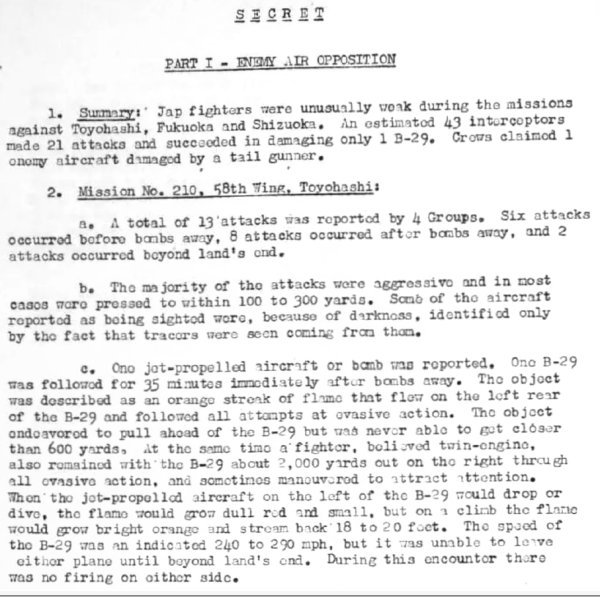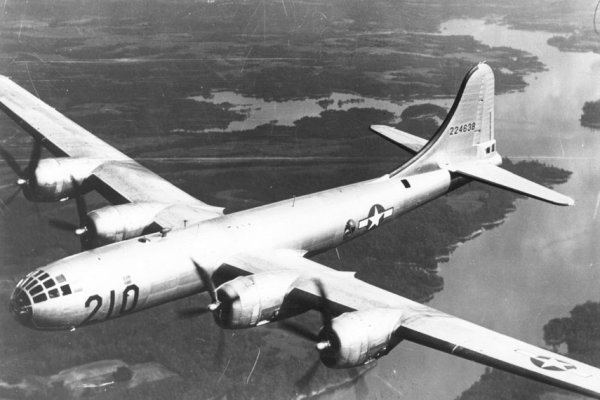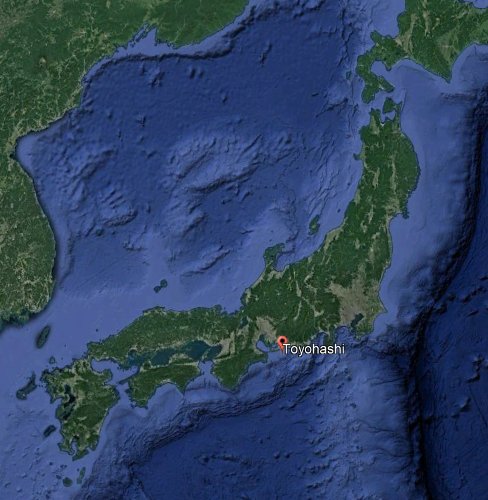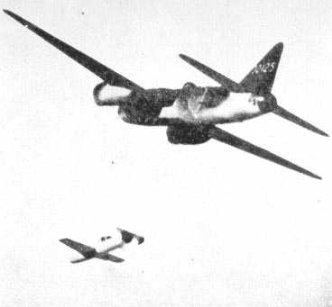ACUFO-1945-05-20-TOYOHASHI-1
The Tactical Mission Report for bombing raid missions 210, 211 and 212 flown over Japan on June 19-20, 1945, of the US Army Air Forces XXIst Bomber Command reported intelligence information on enemy air opposition. Among the observations made during mission No. 210 by B-29's of the 58th Bombardment Wing over Toyohashi, there was:
“c. One jet-propelled aircraft or bomb was reported. One B-29 was followed for 35 minutes immediately after bombs away. The object was described as an orange streak of flame that flew on the left rear of the B-29 and followed all attempts at evasive action. The object endeavored to pull ahead of the B-29 but was never able to get closer than 600 yards. At the same time a fighter, believed twin-engine, also remained with the B-29 about 2,000 yards out on the right through all evasive action, and sometimes maneuvered to attract attention. Then the jet-propelled aircraft on the left of the B-29 would drop or dive, the flame would grow dull red and small, but on a climb the flame would grow bright orange and stream back 18 to 20 feet. The speed of the B-29 was an indicated 240-290 mph, but it was unable to leave either plane until beyond land's end. During this encounter there was no firing on either side.”
| Date: | May 20, 1945 |
|---|---|
| Time: | Between 00:00 a.m. and 03:00 a.m. |
| Duration: | 35 minutes. |
| First known report date: | May 20, 1945 |
| Reporting delay: | Hours. |
| Country: | Japan |
|---|---|
| State/Department: | Aichi |
| City or place: | Toyohashi |
| Number of alleged witnesses: | 1 to 11 |
|---|---|
| Number of known witnesses: | ? |
| Number of named witnesses: | 0 |
| Reporting channel: | Military operation report. |
|---|---|
| Visibility conditions: | Night. |
| UFO observed: | Yes. |
| UFO arrival observed: | ? |
| UFO departure observed: | Yes. |
| UFO action: | Follows, maneuvers up and down, follows evasive actions. |
| Witnesses action: | Evasive actions. |
| Photographs: | No. |
| Sketch(s) by witness(es): | No. |
| Sketch(es) approved by witness(es): | No. |
| Witness(es) feelings: | ? |
| Witnesses interpretation: | ? |
| Sensors: |
[X] Visual: Several.
[ ] Airborne radar: [ ] Directional ground radar: [ ] Height finder ground radar: [ ] Photo: [ ] Film/video: [ ] EM Effects: [ ] Failures: [ ] Damages: |
|---|---|
| Hynek: | NL |
| Armed / unarmed: | Armed, 12 Browning M2 12,7 mm machine guns. |
| Reliability 1-3: | 3 |
| Strangeness 1-3: | 2 |
| ACUFO: | Possible extraterrestrial craft. |
[Ref. aaf1:] US ARMY AIR FORCES:

|
S E C R E T
PART I - ENEMY OPPOSITION
1. Summary: Jap fighters were unusually weak during the mission against Toyohashi, Fukuoka and Shizukoa. An estimated 43 interceptors made 21 attacks and succeeded in damaging only 1 B-29. Crews claimed 1 enemy aircraft damaged by a tail gunner.
2. Mission No. 210, 58th wing, Toyohashi:
a. A total of 13 attacks was reported by 4 Groups. Six attacks occurred before bombs away, 8 attacks occurred after bomb away, and 2 attacks occurred beyond land's end.
b. The majority of the attacks were aggressive and in most cases were pressed to within 100 to 300 yards. Some of the aircraft reported as being sighted were, because of darkness, identified only by the fact that tracers were seen coming from them.
c. One jet-propelled aircraft or bomb was reported. One B-29 was followed for 35 minutes immediately after bombs away. The object was described as an orange streak of flame that flew on the left rear of the B-29 and followed all attempts at evasive action. The object endeavored to pull ahead of the B-29 but was never able to get closer than 600 yards. At the same time a fighter, believed twin-engine, also remained with the B-29 about 2,000 yards out on the right through all evasive action, and sometimes maneuvered to attract attention. Then the jet-propelled aircraft on the left of the B-29 would drop or dive, the flame would grow dull red and small, but on a climb the flame would grow bright orange and stream back 18 to 20 feet. The speed of the B-29 was an indicated 240-290 mph, but it was unable to leave either plane until beyond land's end. During this encounter there was no firing on either side.
The report indicates that Mission 210 targeted a naval arsenal and weapons factories in Toyohashi. The 132 B-29s were ordered to fly between 7,000 and 7,800 feet. The axis of attack was 72 degrees, the target area was 43 miles long, the bomb drop passage was to last 8 minutes, ending with a turn to the right. The Initial Point was at Iwo Jima.
First takeoff was at 190913Z, bombing was from 191558Z to 191817Z, bombers left the coast between 191600Z and 191821Z, last landing was at 200051Z.
The observation therefore took place between May 19, 1945 about 00:00 and May 20, 1945 at 03:00 a.m.
Over the target area there had been 9/10 cloud cover below the planes at 5,000 to 7,000 feet, and 3/10 cloud cover above them at 15,000 feet.
[Ref. prt1:] JAN ALDRICH:
Mission 210-212, 20 June 1945, Fukuoka, Shizuoka, and Toyohashi
2...
One jet-propelled aircraft or bomb was reported. One B-29 was followed for 35 minutes immediately after bombs away. The object was described as an orange streak of flame that flew on the left rear of the B-29 and followed all attempts at evasive action. The object endeavored to pull ahead of the B-29 but was never able to get closer than 600 yards. At the same time a fighter, believed twin-engine, also remained with the B-29 about 2,000 yards out on the right through all evasive action, and sometimes maneuvered to attract attention. Then the jet-propelled aircraft on the left of the B-29 would drop or dive, the flame would grow dull red and small, but on a climb the flame would grow bright orange and stream back 18 to 20 feet. The speed of the B-29 was an indicated 240-290 mph, but it was unable to leave either plane until beyond land's end. During this encounter there was no firing on either side.
....
One B-29 was followed by a strong light after bombs away. This light never closed nor fell back even when the B-29 increases its speed. The enemy plane was finally lost in a cloud. The crew reporting this believed the plane was a night fighter.
3. Mission No. 211, 73rd and 313th Wings, Fukuoka:
a. 73rd Wing:
....
(2) Two balls of fire were observed just before bombs away. One bright 'ball of fire' approached to within 50 yards of 1 B-29 at 7 o'clock low at a very high speed at an altitude of 9,800 feet. The B-29 took slight evasive actions and fired at the object with no apparent results. After the object passed under the B-29, visual contact was lost. No wing or fuselage was seen in connection therewith. Another object having the appearance of a large tracer with trailing smoke passed approximately 100 feet over 1 B-29. Again, no other distinguishing features were noted. Inasmuch as the lighted objects did not trail the B-29's as in the past and considering the number of ground-to-air rockets reported, it was possible that the reported objects were actually rockets.
....
b. 313th Wing:
....
(3) One ball of fire was observed ahead and disappeared into the smoke over the target.
4. Mission 212, 314th Wing, Shizuoka:
....
One of the Baka type bombs and aerial bombs were believed dropped by a large multi-engine plane. The 3 Baka type bombs made no attacks and only 1 followed a B-29 at 1,000 yards.
[Ref. dwn2:] DOMINIQUE WEINSTEIN:
On June 19, 1945, the XXI Bomber Command's B-29s were heading for three targets: the cities of Toyohashi, Fukuoka and Shizuoka. During the mission, B-29 crews reported a variety of aerial phenomena. A B-29 was followed by a strong white light after bombs away. This light never closed, nor fell back, even when the B-29 increased its speed. The “enemy plane” was finally lost in a cloud. The crew reporting they believed the plane was a night fighter.
Sources: Headquarters XXI Bomber Command Tactical Mission Report, June 19/20, 1945, NARA / Strange Company, Keith Chester, 2007.
The Boeing B-29 “Superfortress” was the heaviest bomber of the U.S. Army Air Forces, used in operations from May 8, 1944 and on. Its maximum speed was 574 km/h.
Its defensive armament was 12 Browning M2 12.7 mm machine guns.

|

|
This is again a mind-boggling event of the Pacific Theater B-29 air raids on Japan, with an apparent impossibility to distinguish between the ordinary and the non-ordinary.
We are told that “One jet-propelled aircraft or bomb was reported”, knowing that the Japanese had never had even one operational jet plane, but had the “Baka” piloted rocket suicide bomb. So if this was an enemy craft, it must have been a “Baka”.
The report continues with what may be the same observation or a different one: “One B-29 was followed for 35 minutes immediately after bombs away.” This could not have been a “Baka”, it did not have fuel for a 35 minutes flight - not to mention that it would have been a meaningless flight. We get a description of the object:
“The object was described as an orange streak of flame that flew on the left rear of the B-29 and followed all attempts at evasive action.”
This indicates intelligent control, as opposed to natural phenomena. The report goes on:
“The object endeavored to pull ahead of the B-29 but was never able to get closer than 600 yards.”
But unlike the airmen involved, we do not have any reason to interpret this as an object “unable” to get closer; we could think it just had no intention to get closer.
Then we learn that “At the same time a fighter, believed twin-engine, also remained with the B-29 about 2,000 yards out on the right through all evasive action, and sometimes maneuvered to attract attention.”
This seems to indicate that there was also a twin-engine plane performing the same kind of operating than the “mystery object”, so that the latter does not show a stranger behavior than the enemy plane.
“Then the jet-propelled aircraft on the left of the B-29 would drop or dive, the flame would grow dull red and small, but on a climb the flame would grow bright orange and stream back 18 to 20 feet. The speed of the B-29 was an indicated 240-290 mph, but it was unable to leave either plane until beyond land's end.”
Now, the “object” performs maneuvers that make no sense, drops and climbs just as if the waste fuel for nothing. Any enemy fighter plane could have caught up with the B-29, and one would expect that it would attack the B-29. But: “During this encounter there was no firing on either side.”
The B-29 was flying at a minimum of 240 mph according to the report, the object was seen for 35 minutes, the journey is therefore 225 kilometers at least. The Baka range was 35 kilometers. Furthermore, its maximum speed was 1040 km/h, its cruising speed 840 km/h; this means that it could not have followed the B-29 for that long without stalling.
In the end, I cannot make any sense of what the object was supposed to be or to do. But I would certainly say it was not a Japanese jet, it was not a “Baka”, and it has all the feature of what was called “Foo-Fighters” in other reports.
The Yokosuka MXY-7 Ohka, Allied code name “Baka”, also called “Viper”, was a Japanese rocket plane used for suicide “Kamikaze” missions at the end of World War II. It carried an explosive charge of 1,200 kg, constituting a flying bomb, it was dropped from the belly of a twin-engine Mitsubishi G4M “Betty” bomber. Guidance was provided by the pilot alone, the machine flew at 900 km/h and was not very maneuverable, it is known that many “Baka” had exploded in flight before reaching their target. The first use took place on March 16, 1945, the last recorded use took place on June 22, 1945.
In historical sources, all “Baka” attacks were carried out by day and against ships. I haven't found any mention of a nighttime “Baka” attack on bombers.
Below: photo of the drop of a “Baka” by a Japanese bomber, by day:

|
Possible extraterrestrial craft.
* = Source is available to me.
? = Source I am told about but could not get so far. Help needed.
| Main author: | Patrick Gross |
|---|---|
| Contributors: | None |
| Reviewers: | None |
| Editor: | Patrick Gross |
| Version: | Create/changed by: | Date: | Description: |
|---|---|---|---|
| 0.1 | Patrick Gross | December 30, 2023 | Creation, [aaf1], [prt1], [dwn2]. |
| 1.0 | Patrick Gross | December 30, 2023 | First published. |